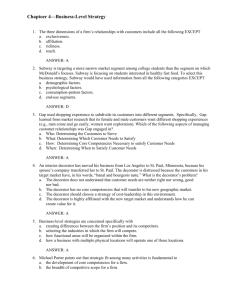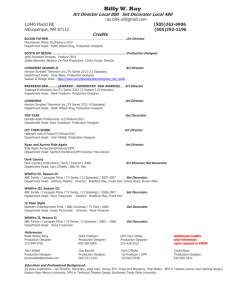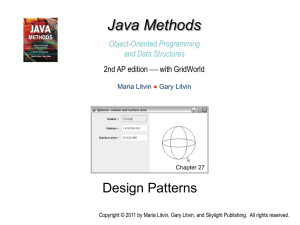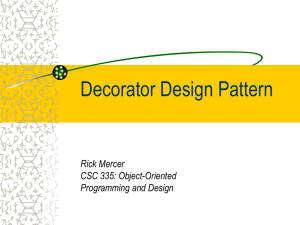UNIT-5 Structural Design Patterns Part
advertisement
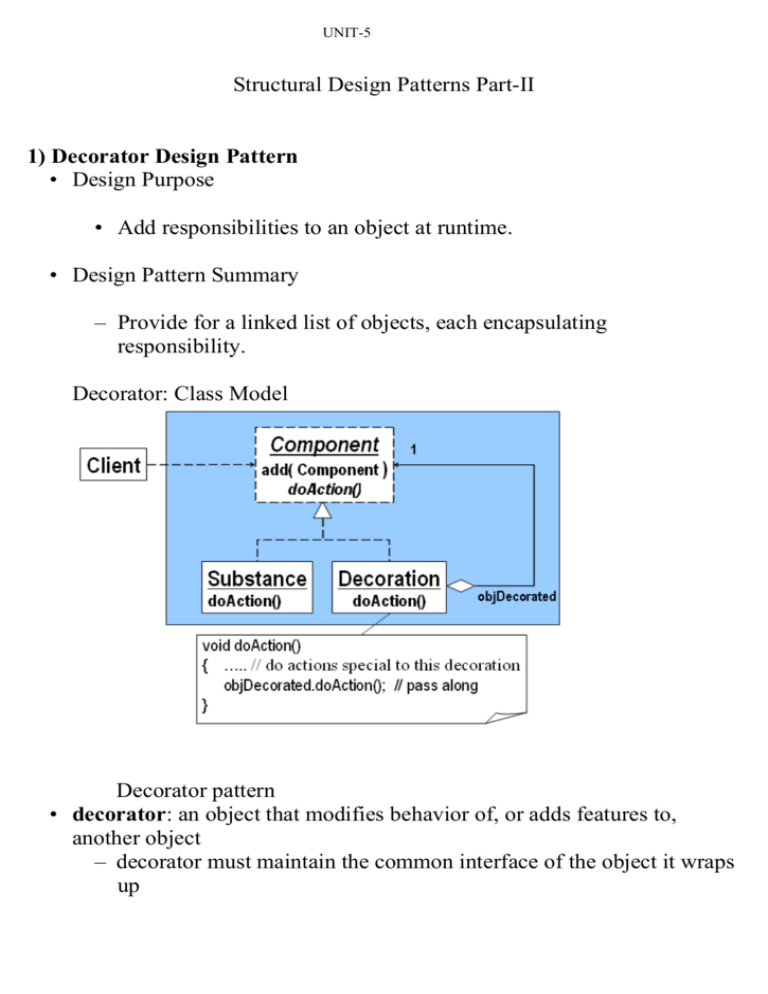
UNIT-5 Structural Design Patterns Part-II 1) Decorator Design Pattern • Design Purpose • Add responsibilities to an object at runtime. • Design Pattern Summary – Provide for a linked list of objects, each encapsulating responsibility. Decorator: Class Model Decorator pattern • decorator: an object that modifies behavior of, or adds features to, another object – decorator must maintain the common interface of the object it wraps up • used so that we can add features to an existing simple object without needing to disrupt the interface that client code expects when using the simple object • examples in Java: – multilayered input streams adding useful I/O methods – adding designs, scroll bars and borders to GUI controls Decorator example: I/O • normal InputStream class has only public int read() method to read one letter at a time • decorators such as BufferedReader or Scanner add additional functionality to read the stream more easily // InputStreamReader/BufferedReader decorate InputStream InputStream in = new FileInputStream("hardcode.txt"); InputStreamReader isr = new InputStreamReader(in); BufferedReader br = new BufferedReader(isr); // because of decorator streams, I can read an // entire line from the file in one call // (InputStream only provides public int read() ) String wholeLine = br.readLine(); • normal GUI components don't have scroll bars • JScrollPane is a container with scroll bars to which you can add any component to make it scrollable // JScrollPane decorates GUI components JTextArea area = new JTextArea(20, 30); JScrollPane scrollPane = new JScrollPane(area); contentPane.add(scrollPane); Decorator Design Pattern Intent: Allow to attach responsibilities to objects, extend their functionality, dynamically Motivation: Consider a WYSIWYG editor The basic textWindow needs various decorations: borders, tool bars, scroll bars, … An “obvious” solution: sub-classing • A sub-class for every option Disadvantages: • Sub-classing is static – compile-time • # of sub-classes = # of combinations – exponential The preferred solution: Use decorator objects • Each decorator adds one decoration – property, behavior Linear • Can add more than one, to obtain combinations of properties • And, do it dynamically Implementation: • Each decorator has a (private) reference to a Component object (CC or D) • For each operation, the decorator performs its decoration job, & delegates Component operations to the Component object it contains • Decorator extends Component (can accept Component requests) Decorators can perform all the operations of Component, often more Decorators can be combined : (but some combinations may hide some functionalities) Consequences : • Decoration can be done dynamically, at run-time • When it makes sense, a decoration can be added several times • The # of decorators is smaller than the # of sub-classes in original solution; avoids lots of feature-heavy classes in the inheritance hierarchy Issues to remember : • A decorator and the Component object it contains are not identical • Many small objects; one has to learn their roles, the legal connections, etc. (but, still much better than sub-classing) Decorators in a java library: Stream decorators A byte stream – r or w bytes Decorators add: • Buffering (does not add services) • r or w primitive types, objects,… (adds services) 2) Facade Design Pattern • Design Purpose • Provide an interface to a package of classes. • Design Pattern Summary – Define a singleton which is the sole means for obtaining functionality from the package. Example: graph interface to a simulation engine SchematicEditor Graph 2 Relatio n Port BufferedRelation Token 0..* Director Entity AtomicEntity CompositeEntity Actor Facade: Encapsulating Subsystems Name: Facade design pattern Problem description: Reduce coupling between a set of related classes and the rest of the system. Solution: A single Facade class implements a high-level interface for a subsystem by invoking the methods of the lower-level classes. Example. A Compiler is composed of several classes: LexicalAnalyzer, Parser, CodeGenerator, etc. A caller, invokes only the Compiler (Facade) class, which invokes the contained classes. Facade Class1 service1() Facade service() Class2 service2() Class3 service3() Consequences: Shields a client from the low-level classes of a subsystem. Simplifies the use of a subsystem by providing higher-level methods. Enables lower-level classes to be restructured without changes to clients. Note. The repeated use of Facade patterns yields a layered system. Motivation • Clients communicate with the package (subsystem ) by sending requests to Facade, which forwards them to the appropriate package object(s). Applicability • To provide simple interface to a complex package, which is useful for most clients. • To reduce the dependencies between the client and the package, or dependencies between various packages. Consequences • It shields clients from package components, thereby reducing the number of objects that clients deal with and making the package easier to use. • It promotes weak coupling between the package and its clients and other packages, thereby promoting package independence and portability. • It doesn't prevent applications from using package classes if they need to. 3) Proxy • You want to – delay expensive computations, – use memory only when needed, or – check access before loading an object into memory • Proxy – has same interface as Real object – stores subset of attributes – does lazy evaluation • Design Purpose • Avoid the unnecessary execution of expensive functionality in a manner transparent to clients. • Design Pattern Summary – Interpose a substitute class which accesses the expensive functionality only when required. L3 Proxy: Class Model Telephone Record Example (Cont’d) Consequences • Proxy promotes: – Efficiency: avoids time-consuming operations when necessary. – Correctness: separates design and code that are independent of retrieval/efficiency from parts concerned with this issue. – Reusability: design and code that are independent of retrieval efficiency are most likely to be reusable. – Flexibility: we can replace one module concerned with retrieval with another. – Robustness: isolates parts that check for the validity of retrieved data. • The penalties we pay can sometimes be too high: – If the proxy forces us to keep very large amount of data in the memory and its use is infrequent. Name: Proxy design pattern Problem description: Improve performance or security of a system by delaying expensive computations, using memory only when needed, or checking access before loading an object into memory. Solution: The ProxyObject class acts on behalf of a RealObject class. Both implement the same interface. ProxyObject stores a subset of the attributes of RealObject. ProxyObject handles certain requests, whereas others are delegated to RealObject. After delegation, the RealObject is created and loaded into memory. Class Diagram Subject request( ) … RealSubject realSubject request() … realSubject->request(); Proxy request() … 4) Flyweight Design Pattern • Design Purpose • Manage a large number of objects without constructing them all. • Design Pattern Summary – Share representatives for the objects; use context to obtain the effect of multiple instances. Flyweighat: Class Model Consequences • Space savings increase as more flyweights are shared. Structure, participants, collaborations: • Component – an interface, describes the operations of a (GUI) component • ConcreteComponent (extends Component) class of objects to which decorations can be added (e.g. the original TextWindow) • Decorator (extends Component)– a class of decorator objects (there are several such classes) Implementation: • Each decorator has a (private) reference to a Component object (CC or D) • For each operation, the decorator performs its decoration job, & delegates Component operations to the Component object it contains • Decorator extends Component (can accept Component requests) Class Diagram Facade Class1 service1() Facade service() Class2 service2() Class3 service3()
